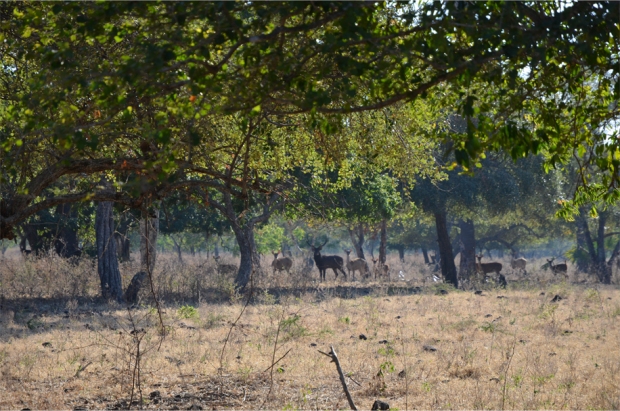Big sky country: photos from Baluran
Several years ago, while asleep in a bungalow not far from a beach in Lombok, Indonesia, I was rudely awakened by the shrill sound of a mosquito buzzing in my ear. Bama and I eventually killed the thing, but I couldn’t forget what it said to me that night: “Uaaaaaang.” For the mosquito had been speaking a language I half-understood. Uang, it turns out, is the Indonesian word for money.
Fast forward to the summer of 2015. Two weeks have elapsed since the end of Ramadan, and we are back in Indonesia, in the wilds of Baluran National Park. Bama and I are transfixed by the sight of deer and peacocks congregating in the shade just below our perch. We observe them in silence from a nondescript observation post, its concrete parapet and makeshift barriers of woven palm leaf enough to disguise us from the skittish animals. Earlier on, Bama had spoken about the Javanese habit of mispronouncing double L’s as W’s, and it suddenly dawns on me what the peacocks are saying: “Awwwohhh! Awwwohhh!”
Here in Indonesia, mosquitoes beg for money and peacocks call on God. I know it is a gross misinterpretation, a vain attempt to extract meaning out of nothing at all, but it is poetic nonetheless. The mosquitoes attempt to extort money in order to survive, while the peacocks invoke the name of a higher power in their search for a mate.
Depending on your point of view, Baluran lies either at the beginning or the end of Java. It sprawls across a forgotten corner in the far eastern fringes of the island. The sun rises here half an hour before it does in Jakarta, and on the horizon the hills of Bali are visible across a narrow strait.
The Dutch called this place Afrika van Java – no doubt the colonials were struck by its dry, grassy landscape quite unlike the rest of the island. We are too. The scenery is awe-inspiring; we marvel at the endless skies over the savannah of Bekol, and the strange trees that soar many metres into the air, their solitary trunks culminating in a parched crown.
After sunset, the evening breeze sweeps up from the ocean and rides in across the savannah, reaching into the upper floor of our bare-bones guesthouse. Enterprising mice have gnawed little holes in the walls and floorboards, and the verandah is caged not to keep us in, but to keep foraging monkeys out. The dark mass of Mt. Baluran, an extinct volcano, broods in the distance. Instead of motorbikes and the thumping beat of raunchy dangdut music, we hear chirping crickets, geckos and the low, rumbling growls of the resident deer.
By day, peacocks roam through the grass, and troupes of opportunistic long-tailed macaques watch us, wide-eyed but also fearful, from the side of the stony road. Beyond the rangers’ office we find a breeding enclosure for the endangered Javanese banteng, a wild ox driven to the extreme edges of the island by the pressures of an exploding human population. Male bantengs are almost entirely black except for their rump and white legs (as though wearing socks); the females are less striking, being the tan of an ordinary cow, but with telltale patches of white in those same places.
We spend most of our time shuttling between the savannah and a beach that coincidentally bears Bama’s name. I had erroneously believed that the beach was our main reason for coming, but Bama is not that kind of person. He’d read up on the wildlife and seen pictures of the savannah, with its backdrop of a proud, shattered volcano long before we even planned the trip. Baluran may be a vision of Africa in Java, but as a rare pocket of wilderness on the world’s most populous island, it is remarkable simply because it still exists. ◊




























Absolutely stunning sunrise photos by the beach! Love those.
Thanks! We were so lucky to see the sunrise in all its glory.
A very different Indonesia. Those “strange trees” – if you mean the palms, they’re also found in northern Lanka and Southern India.
Ah, it looks like those dry, withered trees are indeed palms at the end of their life cycles. I was wondering why they’d lost their fronds and took on such a different appearance.
What a lovely place. Especially the talking animals.
It was such a nice way to wrap up a month in Java. Next time I’ll have to bring a telephoto lens!
Oh no, that photo! 😀 The accommodation at Bekol was indeed the most modest and basic throughout our six-month journey. But the tranquility, the wide expanse of the savanna, those wild animals and the majestic backdrop of Mount Baluran really justified our two-night stay in the national park. Oh and the lady at the canteen was one of the friendliest people I met on the trip. A really nice post, James. And superb photos too!
Makasih Bama, I hope you don’t mind the picture! 😉 Yes, it was so generous and considerate of that lady to keep the canteen open for the sake of us travellers – otherwise we’d have had gone hungry on our second day there.
For mosquitoes, I think blood is their money. It’s easy for me to imagine a mosquito bloated with more blood than it needs trading that hard earned money from a long night’s jabbing and sucking for something else it wants. Use your imagination.
The Incas used jade as money. I’ve read they were relived when the Spanish only wanted their gold becasue the Incas valued jade more than they did gold. Why not blood for mosquitoes?
I hadn’t heard that story about the Incas. It is fascinating to think that jade was valued so highly at opposite ends of the Pacific. To take the mosquito idea even further, I guess we can say that in their eyes, money runs in our veins.
Not what I expected to see in Java. some of the photos, especially the savannah do look like Africa. Thanks for introducing me to a very different/beautiful part of Java.
You’re welcome. Baluran is just up the coast from Ijen but it feels completely different – as though it involves crossing to another island.
Your last sentence summed up what I was thinking as I read along: It is amazing this place exists. With 140 million people on one island, it is amazing there is any wilderness left.
Other than money and god, how is your Indonesian these days?
Absolutely, Jeff. 140 million people… that’s like 45 percent of the US population crammed into Java alone!
My Indonesian is a bit rusty at the moment. I’ve been itching to take a class of some sort but there isn’t anything like that in Hong Kong. Ordering food and making small talk at Indonesian restaurants has been fun, although people tend to talk really fast!
Amazing.
Yep, Baluran was a real surprise.
James… hahaha… did those animals really sound ‘uaaaaang’ and ‘awwwoooh’?? LOL… never thought that far hahaha…
And about your photos.. as usual stunning…
Makasih Riyanti. I’m not kidding about the animals – I swear that’s exactly how they sounded! 😀
Great Travels! How are you financially sustaining going to all of these places ?
We see that you worked for the publishing agency but how about prior to and afterwards ?
I guess I have been incredibly fortunate. After college I decided to move back in with my parents – it is very common here in Hong Kong since the rental and housing prices are through the roof. Not needing to worry about the rent has made saving for travel a lot easier.
None of the trips shown here were financed by the publishing firm I used to work for. Most of my travels around Europe took place when I lived overseas (in the UK and Spain). Since moving back to Hong Kong, I generally only travel within the region – Southeast Asia is a great choice given the lower hotel/hostel prices and the presence of budget carriers like AirAsia.
Ah, makes perfect sense. Have minimal expenses and spend on what matters.
What a beautiful place. I would never have expected to find such a place in Indonesia. Are the deer and peacocks native or introduced?
Alison
It was wildly different to all the other places I visited on Java. The deer and peacocks are native – though we did see some feral water buffalo inside the park. I think you’d take much better wildlife shots than I did!
James
You alluded to Africa in one of your captions and, indeed, the landscape here is incredibly reminiscent of the African savannah! Mt Baluran itself could be the long-lost twin of the misty volcano, Ol Doinyo Lengai, I saw in Tanzania. The earth is a wondrous place!
Lex, I hadn’t heard about Ol Doinyo Lengai until now. The subsequent Google search had me wondering when I would make that dream trip to Tanzania. It resembles some of the other volcanoes I’ve seen around Indonesia – Mt. Baluran must have looked identical before blowing its top off all those years ago!
Wonderful talking animals and really beautiful photos!
Thank you, Minna!
Your landscape photos are superb – I especially like those odd trees – and I’m glad there is still habitat for some wild animals!
Much appreciated, Marilyn. Sadly I couldn’t get any closeups of those animals – most of them (except the monkeys) were very shy!
The place is indeed beautiful, but … I hvnt’ got a chance to go there
Love the photo of the forest canopy. So u need to go up higher enough to get this photo?
You should go, Timothy – it is truly not like anywhere else in Java! We climbed an observation tower on a small hill to get that view. If you look very, very closely you can even see lutung in the branches.
Looks sublimely beautiful James! The forest canopy is my favourite, and the mountain silhouette. The Banteng with its white stockings, bears a strong resemblance to the Indian Gaur – we erroneously call it bison – but seems much smaller. Here’s wishing this pocket of wilderness continues to flourish.
Oh, and I forgot to add: Cute photo of Bama on Bama Beach! 🙂
Judging from the photos on Google, the Indian Gaur looks like a veritable beast! A telephoto lens would have come in very handy in Baluran… I had no luck getting shots of the gorgeous black Lutung hanging out in the forest canopy. As for that photo of Bama, it was very strange to see his name everywhere on the beach!
😍😍😍😍😍😍😍
😀
Had some photos taken from the same sport may be a month ago. Nice to see it throughout your lens. If you curious, dig in my post around 13-25 of march
It’s nice to hear that you were there recently. Baluran is such a special place.